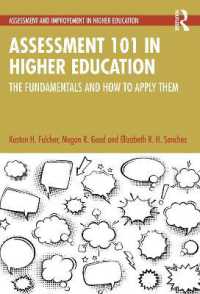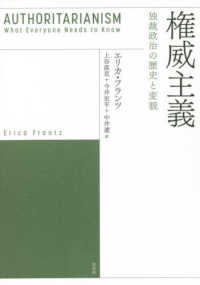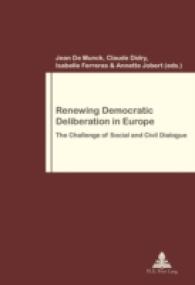- ホーム
- > 洋書
- > 英文書
- > History / World
Full Description
The analysis of stable isotope ratios of carbon and nitrogen in bone collagen provides a powerful tool for reconstructing past diets, since it provides the only direct evidence of the foods that were actually consumed. The chapters that comprise this volume describe the application of this methodology to the archaeology of Greece, a country whose archaeobotanical remains have been isotopically studied more extensively than any other place in the world. The archaeological issues that can be addressed using stable isotope methods include the importance of fishing; the possible early introduction of millet; the nature of childrearing including weaning age and weaning foods; temporal shifts in protein consumption; differential access to certain foods associated with social status as well as gender and age; and cultural differences in dietary patterns. Additionally, diet is strongly correlated with health or stress markers in the teeth and bones. Knowing what people ate has vital implications for our understanding of past environments and economies, subsistence strategies, and nutrition.
Contents
List of Illustrations
List of Tables
Chapter 1 Introduction, by Anastasia Papathanasiou and Sherry C. Fox
Chapter 2 Stable Isotope Analysis of Bone and Teeth as a Means for Reconstructing Past Human Diets in Greece, by Michael P. Richards
Chapter 3 Stable Isotope Analyses in Neolithic and Bronze Age Greece: An Overview, by Anastasia Papathanasiou
Chapter 4 Stable Isotope Analysis of Skeletal Assemblages from Prehistoric Northern Greece, by Sevasti Triantaphyllou
Chapter 5 Variations in Diet in Prehistoric Thebes: The Case of the Bronze Age Mass Burial, by Efrossini Vika
Chapter 6 Existence and Subsistence in Mycenaean-Era East Lokris: The Isotopic Evidence, by Carina A. Iezzi
Chapter 7 Dietary Reconstruction at the Geometric-Period Burial Site of Ayios Dimitrios, by Eleni Panagiotopoulou and Anastasia Papathanasiou
Chapter 8 Diet and the Polis: An Isotopic Study of Diet in Athens and Laurion during the Classical, Hellenistic, and Imperial Roman Periods, by Anna Lagia
Chapter 9 Stable Isotope Evidence for Infant Feeding Practices in the Greek Colony of Apollonia Pontica, by Cynthia S. Kwok and Anne Keenleyside
Chapter 10 Bread, Oil, Wine, and Milk: Feeding Infants and Adults in Byzantine Greece, by Chryssi Bourbou and Sandra Garvie-Lok
Chapter 11 Summary: Patterns in the Carbon and Nitrogen Isotope Data through Time, by Anastasia Papathanasiou and Michael P. Richards
Index








